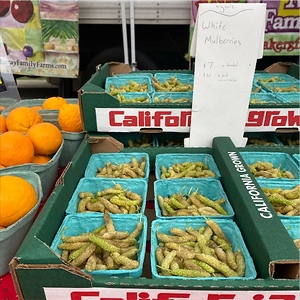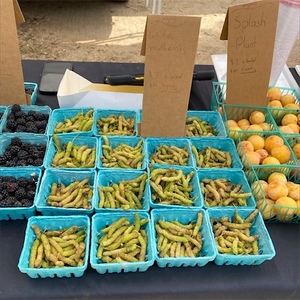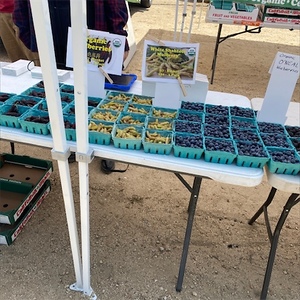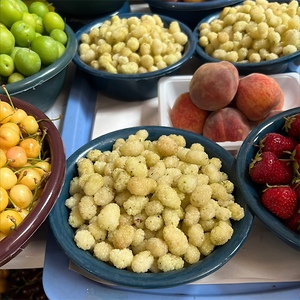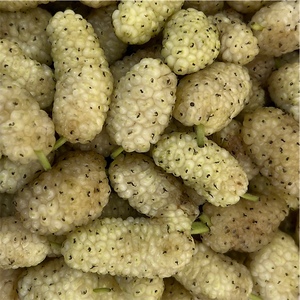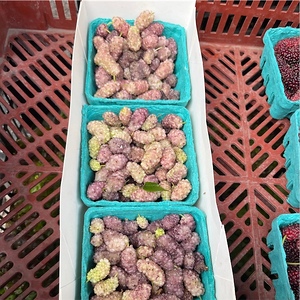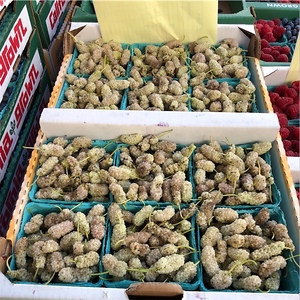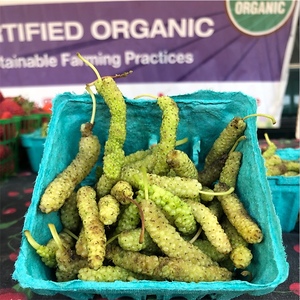

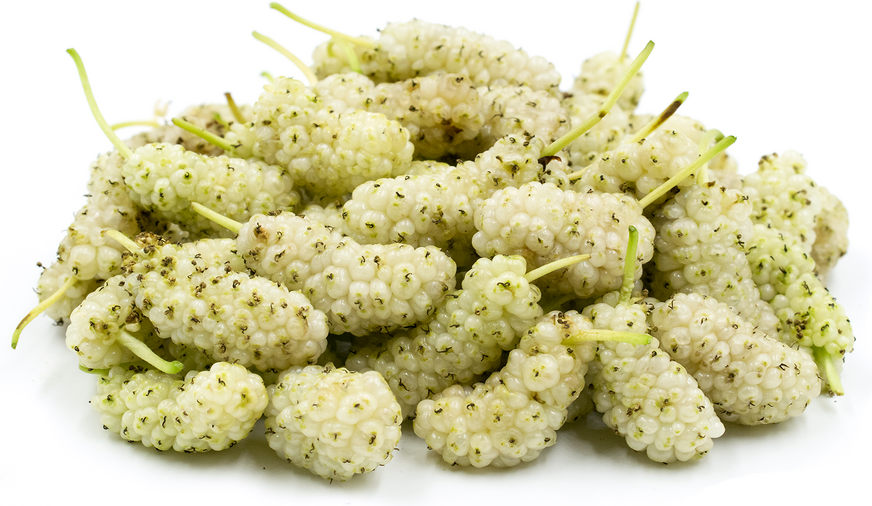
White Mulberries
Estimated Inventory, bskt : 0
Description/Taste
White mulberries are typically smaller than other mulberry species, averaging 1 to 2.5 centimeters in length, and are aggregate fruits composed of tiny individual drupes clustered around a central stem. Each mulberry has a short, plump, and cylindrical shape with rounded, blunt ends. The fruit’s surface is pebbled and bumpy due to the fusion of the tiny drupes, and the skin is thin, showcasing a smooth, taut, and semi-glossy appearance. The shininess will fade into a dull, almost matte look as the fruit matures and sweetens. The skin is also delicate, being easily bruised, punctured, or squished, giving the fruits a short shelf life. White mulberries ripen from shades of green or white to shades of pale red, white, pink-white, red, to dark purple. Some lighter fruits may also showcase a slightly translucent nature. Underneath the surface, the flesh is firm, tender, and aqueous, with many seeds creating a succulent but crisp consistency. There is also a stringy core found in the center of the flesh. This core is edible but does not have flavor. Some consumers eat the core, while others pull the fruit through their teeth to scrape the flesh from the core, then discard it. White mulberries can be eaten raw or cooked and are high in sugar and low in acidity, creating a mild, slightly bland, sugary taste. The young leaves are also edible and have a neutral, green, and grassy flavor.
Seasons/Availability
White mulberries are available in the late spring through mid-summer.
Current Facts
White mulberries, botanically classified as Morus alba, are an Asian species belonging to the Moraceae family. The small, sweet fruits grow on deciduous trees reaching 10 to 20 meters in height and are a fast-growing species easily adaptable to regions worldwide. It is important to note that the term White mulberries is a general descriptor for many varieties of mulberry trees within the species, and not all cultivars produce white fruits. The name White mulberries is said to be a descriptor of the tree's white flowers. White mulberry trees produce fruits that can be white, pink, or red, and the fruits are not actual berries but aggregate fruits, meaning they are comprised of many small fleshy drupes fused on a single stem. Historically, White mulberries are known as the sole food source of silkworms to encourage silk production, but over time, the species has become favored among foragers for its mild, sweet fruits. White mulberries will naturally fall off the tree when ripe, and the fruits can also be hand-picked for use in sweet or savory culinary preparations. The fruits are not commercially produced as they squish and bruise easily and have a short shelf life, but they are found through local markets as a specialty ingredient, sometimes labeled as Silkworm mulberries and Asian mulberries.
Nutritional Value
White mulberries are a source of potassium to balance fluid levels within the body, fiber to regulate the digestive tract, and vitamin C to strengthen the immune system while reducing inflammation. The fruits also provide vitamin E to protect the cells against the damage caused by free radicals, iron to develop the protein hemoglobin for oxygen transport through the bloodstream, vitamin K to assist in faster wound healing, and other nutrients, including folate, manganese, vitamin A, B vitamins, and riboflavin. Young White mulberry leaves have some calcium to build strong bones and teeth, zinc to boost immunity, and iron. In Traditional Chinese Medicine, White mulberries are valued for their anti-inflammatory properties and are used to reduce fatigue, lower fevers, assist in symptoms associated with anemia, and soothe sore throats. The species is also used to purify the blood.
Applications
White mulberries have a mild, sweet, and somewhat neutral flavor suited for fresh and cooked preparations. The fruits are only consumed when ripe and can be eaten out of hand, tossed into salads, or mixed into a fruit bowl. White mulberries can be used in any recipe calling for mulberries, and add sweet notes as an edible topping over pancakes, porridge, and grain bowls. White mulberries can also be stirred into yogurt or blended and frozen into popsicles, sorbet, and ice cream. In addition to fresh preparations, White mulberries are incorporated into Danishes, bread, muffins, cakes, pies, and crumbles, and their high sugar content creates sweet syrups, jams, and jellies. In Turkey, White mulberries are cooked into sweet molasses known as pekmez. This syrup is nicknamed the "healing syrup of Anatolia" for its nutritional properties, and the syrup is traditionally combined with tahini and sesame paste as a spread. This thick spread is slathered over bread and is a customary part of Turkish breakfasts. In China and Korea, White mulberry leaves are steeped into a medicinal tea. Beyond culinary preparations, White mulberries are commonly blended into smoothies, fermented into kombucha, or muddled into iced tea or lemonade. The fruits are also used to flavor cocktails such as mojitos or brambles and are famously used to make wine. White mulberries have a short shelf life and can be dried for extended use. Dried White mulberries have a chewy, gummier texture like a fig and can be mixed into salads, oatmeal, smoothies, granola, and granola bars. The dried fruits can be used as a substitute for raisins in recipes, and mulberries, in general, can also be cooked and dried into fruit leather. White mulberries pair well with fruits such as other berries, stone fruit, and citrus, young cheeses such as burrata, chevre, and mascarpone, meats including pork, duck, and wild game, herbs such as basil, lavender, and mint, cinnamon, and nuts including pecans, walnuts, and almonds. Whole, unwashed White mulberries are highly perishable and will keep for 2 to 3 days when stored in the refrigerator on top of paper towels and covered in plastic wrap. The fruits can also be dried or frozen for extended use.
Ethnic/Cultural Info
Mulberries are famously intertwined into the story of Pyramus and Thisbe. The tale was first recorded in the Roman poet Ovid's Metamorphoses, a fifteen-book compilation of mythology, legends, and other stories written around 8 CE. Pyramus and Thisbe is a Babylonian love story recounting a couple who lived next door to each other and were forbidden to have a relationship due to their feuding families. Pyramus would whisper to Thisbe his love for her through the cracks in the house walls, and one day they set a plan to meet under a White mulberry tree to run away and elope. Thisbe arrived at the White mulberry tree first, but to her surprise, she was met by a lioness who had just finished eating. Frightened at the blood-soaked lioness, Thisbe fled, accidentally leaving her cloak behind. When Pyramus arrived, he saw the lioness and Thisbe's tattered cloak that had been shredded by the lioness and was heartbroken at the sight. He thought the blood on the lioness was from Thisbe being attacked, and in his sorrow, he fell on his sword as he couldn't live another minute without his love. When Pyramus committed this act, blood splattered the White mulberry tree, leaving a red coloring on the pale fruits. Thisbe returned to the mulberry tree to find Pyramus dead, and in her tragedy, she used the same sword to take her own life. The gods were touched by Thisbe and Pyramus's love for each other, so in an act of remembrance, they turned the White mulberry fruits into shades of red to honor the couple's eternal love for each other.
Geography/History
White mulberries are native to China, and the trees have been growing wild since ancient times. The species is historically known for its significance as the sole food source for silkworms in Asia. White mulberry leaves have been used as a food source for silkworms for over 4000 years, and the species was spread throughout Asia, the Middle East, and Europe along the Silk Road trade routes for increased silk production. White mulberry trees were planted throughout Ancient Greece and Rome, and the species was prevalent throughout Europe by the 12th century. In the 15th century, White mulberries were carried to the New World by the Spanish and were planted in Latin America. Later in the early 17th century, the United States began importing White mulberry trees to jumpstart a North American silk industry. In 1624, the Virginia legislature ordered residents to plant at least four White mulberry trees, and by the 1830s, "mulberry mania" ensued throughout the United States, only to have the trees killed later that decade by disease and cold winters. Today White mulberry trees are grown worldwide and have escaped cultivation in non-native regions, naturalizing in disturbed land such as fields, grasslands, forests, pastures, along fences, roadsides, and woodlands. The trees are also sometimes planted in parks and home gardens. In parts of the United States and Australia, White mulberries are considered an invasive species as they grow quickly and can destroy parking lots, sidewalks, and building foundations. When in season, White mulberries are foraged from wild, naturalized, and cultivated trees and are sold in fresh markets and farmer's markets worldwide. The fruits are generally not grown commercially due to their delicate and perishable nature.
Recipe Ideas
Recipes that include White Mulberries. One



